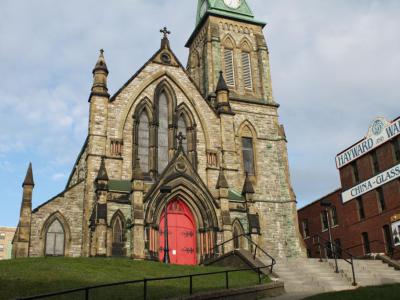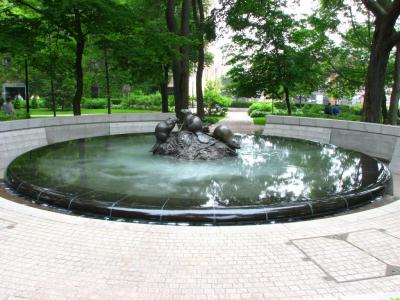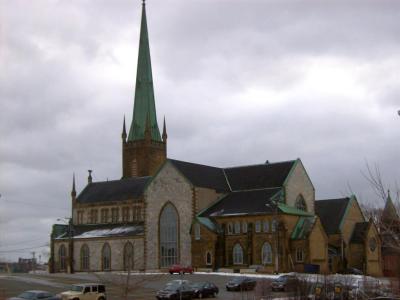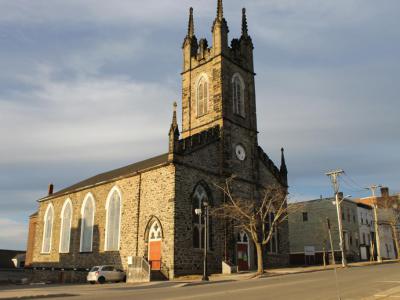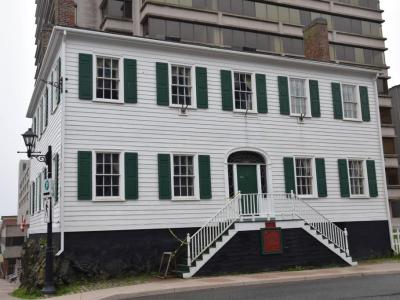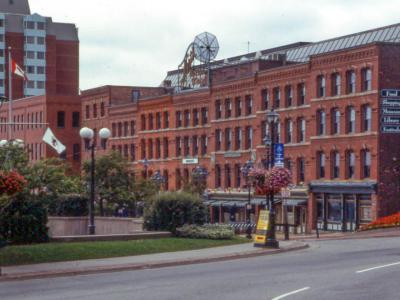Saint John Introduction Walking Tour (Self Guided), Saint John
A major seaport on the Bay of Fundy in the Canadian province of New Brunswick, Saint John is a vibrant, up-and-coming hub, with a fascinating maritime history, and more than its fair share of natural beauty.
Being the oldest incorporated city in Canada, established by royal charter during the reign of King George III in the 1780s, Saint John is the only true city in this part of the country. Originally, the area was settled by the French. Explorer Samuel de Champlain first landed in the local harbor on June 24, 1604 (the feast of Saint John the Baptist), hence the area's name.
After more than a century of ownership disputes between the French and English over this land, the British government constructed Fort Howe above the harbor in 1779. In 1785, the City of Saint John was established by uniting the two communities of Parrtown and Carleton on either side of the harbor after the arrival of thousands of refugees from the newly founded United States who wished to remain British after the American Revolution. During the next century, immigration via Partridge Island, especially during the Great Famine, would fundamentally change the city's demographics and culture.
One of the most iconic landmarks in Saint John is the City Market, a bustling center of activity since 1876. Here, locals and visitors alike gather to peruse fresh produce, artisanal crafts, and delicious cuisine, creating a vibrant atmosphere that showcases the city's community spirit.
Adjacent to the market lies King's Square, a picturesque park surrounded by historic buildings and Victorian-era architecture.
Culture enthusiasts will delight in the Imperial Theatre, a beautifully restored venue hosting a variety of performances, from Broadway shows to local productions. Nearby, Trinity Anglican Church stands as a stunning example of Gothic Revival architecture, offering a glimpse into the city's religious heritage.
For those interested in delving deeper into Saint John's past, the Jewish Historical Museum and Loyalist Burial Ground provide insight into the city's history, while the Cathedral of the Immaculate Conception and the Stone Church showcase its religious diversity.
Another location of note is the Loyalist House, a meticulously preserved residence offering a glimpse into the city's life in the early 19th century.
Finally, a visit to Saint John would not be complete without exploring Market Square, a vibrant entertainment complex featuring shops, restaurants, and other delights.
To discover Saint John in its variety, we invite you on this self-guided introductory tour. Experiencing firsthand the spirit of this enchanting maritime destination on the eastern coast of Canada will prove worth your while!
Being the oldest incorporated city in Canada, established by royal charter during the reign of King George III in the 1780s, Saint John is the only true city in this part of the country. Originally, the area was settled by the French. Explorer Samuel de Champlain first landed in the local harbor on June 24, 1604 (the feast of Saint John the Baptist), hence the area's name.
After more than a century of ownership disputes between the French and English over this land, the British government constructed Fort Howe above the harbor in 1779. In 1785, the City of Saint John was established by uniting the two communities of Parrtown and Carleton on either side of the harbor after the arrival of thousands of refugees from the newly founded United States who wished to remain British after the American Revolution. During the next century, immigration via Partridge Island, especially during the Great Famine, would fundamentally change the city's demographics and culture.
One of the most iconic landmarks in Saint John is the City Market, a bustling center of activity since 1876. Here, locals and visitors alike gather to peruse fresh produce, artisanal crafts, and delicious cuisine, creating a vibrant atmosphere that showcases the city's community spirit.
Adjacent to the market lies King's Square, a picturesque park surrounded by historic buildings and Victorian-era architecture.
Culture enthusiasts will delight in the Imperial Theatre, a beautifully restored venue hosting a variety of performances, from Broadway shows to local productions. Nearby, Trinity Anglican Church stands as a stunning example of Gothic Revival architecture, offering a glimpse into the city's religious heritage.
For those interested in delving deeper into Saint John's past, the Jewish Historical Museum and Loyalist Burial Ground provide insight into the city's history, while the Cathedral of the Immaculate Conception and the Stone Church showcase its religious diversity.
Another location of note is the Loyalist House, a meticulously preserved residence offering a glimpse into the city's life in the early 19th century.
Finally, a visit to Saint John would not be complete without exploring Market Square, a vibrant entertainment complex featuring shops, restaurants, and other delights.
To discover Saint John in its variety, we invite you on this self-guided introductory tour. Experiencing firsthand the spirit of this enchanting maritime destination on the eastern coast of Canada will prove worth your while!
How it works: Download the app "GPSmyCity: Walks in 1K+ Cities" from Apple App Store or Google Play Store to your mobile phone or tablet. The app turns your mobile device into a personal tour guide and its built-in GPS navigation functions guide you from one tour stop to next. The app works offline, so no data plan is needed when traveling abroad.
Saint John Introduction Walking Tour Map
Guide Name: Saint John Introduction Walking Tour
Guide Location: Canada » Saint John (See other walking tours in Saint John)
Guide Type: Self-guided Walking Tour (Sightseeing)
# of Attractions: 10
Tour Duration: 2 Hour(s)
Travel Distance: 3.0 Km or 1.9 Miles
Author: DanaOffice
Sight(s) Featured in This Guide:
Guide Location: Canada » Saint John (See other walking tours in Saint John)
Guide Type: Self-guided Walking Tour (Sightseeing)
# of Attractions: 10
Tour Duration: 2 Hour(s)
Travel Distance: 3.0 Km or 1.9 Miles
Author: DanaOffice
Sight(s) Featured in This Guide:
- City Market
- King's Square
- Imperial Theatre
- Trinity Anglican Church
- Jewish Historical Museum
- Loyalist Burial Ground
- Cathedral of the Immaculate Conception
- Stone Church
- Loyalist House
- Market Square
1) City Market (must see)
The Saint John City Market, designated as a National Historic Site of Canada, stands proudly as a significant landmark in the heart of Saint John. This substantial brick building, completed in 1876, occupies an entire city block and is situated across from the northwestern corner of King Square in the central business district.
Designated as a national historic site in 1986, the Saint John City Market holds this prestigious status due to various noteworthy features. Its market hall interior, the commercial Second Empire facade along Water Street, and the two side elevations on North and South Market Street collectively contribute to its historical significance. It stands as a rare and distinguished example of a 19th-century building purposefully designed to serve as a market.
The formal entry facade, showcasing a distinctive three-and-a-half storey Second Empire-Style office block, elegantly faces King Square. As visitors venture beyond this facade, they discover the market hall, a captivating space characterized by double height openness. The hall is organized around a broad central aisle, with individual stalls lining both sides. The architectural charm of the market is enhanced by the exposed timber framing, queen post trusses, and cast iron columns that support the structure.
Constructed by New Brunswick architects McKean and Fairweather between 1874 and 1876, the Saint John City Market possesses a solid and fire-resistant structure. Notably, it withstood the challenges posed by the Great Fire of 1877 and underwent subsequent renovations over the years. These efforts have allowed the market to endure as a vital civic structure, preserving its original function and continuing to serve as a vibrant hub for the community.
Designated as a national historic site in 1986, the Saint John City Market holds this prestigious status due to various noteworthy features. Its market hall interior, the commercial Second Empire facade along Water Street, and the two side elevations on North and South Market Street collectively contribute to its historical significance. It stands as a rare and distinguished example of a 19th-century building purposefully designed to serve as a market.
The formal entry facade, showcasing a distinctive three-and-a-half storey Second Empire-Style office block, elegantly faces King Square. As visitors venture beyond this facade, they discover the market hall, a captivating space characterized by double height openness. The hall is organized around a broad central aisle, with individual stalls lining both sides. The architectural charm of the market is enhanced by the exposed timber framing, queen post trusses, and cast iron columns that support the structure.
Constructed by New Brunswick architects McKean and Fairweather between 1874 and 1876, the Saint John City Market possesses a solid and fire-resistant structure. Notably, it withstood the challenges posed by the Great Fire of 1877 and underwent subsequent renovations over the years. These efforts have allowed the market to endure as a vital civic structure, preserving its original function and continuing to serve as a vibrant hub for the community.
2) King's Square (must see)
Established in 1785, just a year after the formation of New Brunswick, the King's Square was aptly named after King George III. Over the years, it has become a cherished space adorned with various monuments and plaques, each paying homage to individuals who have played pivotal roles in shaping the city's history.
At the heart of King's Square stands the majestic King Edward VII Memorial Bandstand, a two-storey architectural gem crowned with a copper roof and adorned with an intricate metal framework. This bandstand, donated in 1909 by the City Coronet Band, serves as a central focal point and a symbol of homage to King Edward VII.
The park hosts various monuments, each with its own story. A marker in honor of Charles Gorman, a local speed skater who participated in the 1924 and 1928 Winter Olympics, adds a touch of athleticism to the square. On the east side, a 20-foot tall monument commemorates John Frederick Young, a heroic 19-year-old who tragically drowned while attempting to rescue a 10-year-old boy in nearby waters on October 30, 1890.
Among the notable monuments is "The Loyalist Cross," erected in 1934 to honor the first settlers representing the province. Unveiled on New Brunswick's 150th anniversary, this cross stands as a timeless tribute to the enduring spirit of those who laid the foundation for the region. King's Square, with its blend of natural beauty and historical significance, remains a cherished gathering place for the community.
At the heart of King's Square stands the majestic King Edward VII Memorial Bandstand, a two-storey architectural gem crowned with a copper roof and adorned with an intricate metal framework. This bandstand, donated in 1909 by the City Coronet Band, serves as a central focal point and a symbol of homage to King Edward VII.
The park hosts various monuments, each with its own story. A marker in honor of Charles Gorman, a local speed skater who participated in the 1924 and 1928 Winter Olympics, adds a touch of athleticism to the square. On the east side, a 20-foot tall monument commemorates John Frederick Young, a heroic 19-year-old who tragically drowned while attempting to rescue a 10-year-old boy in nearby waters on October 30, 1890.
Among the notable monuments is "The Loyalist Cross," erected in 1934 to honor the first settlers representing the province. Unveiled on New Brunswick's 150th anniversary, this cross stands as a timeless tribute to the enduring spirit of those who laid the foundation for the region. King's Square, with its blend of natural beauty and historical significance, remains a cherished gathering place for the community.
3) Imperial Theatre
The Imperial Theatre stands as a historic gem with a rich legacy dating back to its opening on September 19, 1913. Designed by the renowned Philadelphia architect Albert Westover, the theatre was commissioned by the Keith-Albee-Orpheum Corporation, a vaudeville chain from New York City.
As one of Canada's early entertainment venues, the Imperial Theatre witnessed the performances of The Dumbbells, one of the country's first comedy troupes, showcasing several of their initial shows within its walls. The theatre also played a significant role in the early days of silent cinema, featuring films by iconic stars such as Charlie Chaplin, Buster Keaton, Fatty Arbuckle, Greta Garbo, and Harold Lloyd.
Architecturally, the Imperial Theatre is a testament to modern adaptation, drawing inspiration from the Italian Renaissance. Its design seamlessly blended functionality for live vaudeville acts and the emerging era of "talkies," highlighting its versatility as an entertainment venue.
In 1929, reflecting changing times, the theatre underwent a name change to the Capitol Theatre and, like many vaudeville houses of the era, transitioned into a cinema. For several decades, from 1957 to 1982, the Imperial Theatre took on a different role, serving as a meeting space for the Full Gospel Assembly.
The year 1982 marked a turning point when the Imperial Theatre, after a period of disuse, underwent extensive restoration and revitalization efforts. Today, the Imperial Theatre stands as a fully restored Victorian proscenium arch-type facility. The arch, a spectacular architectural achievement, elegantly frames the stage from every viewing position, providing a captivating setting for a diverse range of performances and cultural events.
As one of Canada's early entertainment venues, the Imperial Theatre witnessed the performances of The Dumbbells, one of the country's first comedy troupes, showcasing several of their initial shows within its walls. The theatre also played a significant role in the early days of silent cinema, featuring films by iconic stars such as Charlie Chaplin, Buster Keaton, Fatty Arbuckle, Greta Garbo, and Harold Lloyd.
Architecturally, the Imperial Theatre is a testament to modern adaptation, drawing inspiration from the Italian Renaissance. Its design seamlessly blended functionality for live vaudeville acts and the emerging era of "talkies," highlighting its versatility as an entertainment venue.
In 1929, reflecting changing times, the theatre underwent a name change to the Capitol Theatre and, like many vaudeville houses of the era, transitioned into a cinema. For several decades, from 1957 to 1982, the Imperial Theatre took on a different role, serving as a meeting space for the Full Gospel Assembly.
The year 1982 marked a turning point when the Imperial Theatre, after a period of disuse, underwent extensive restoration and revitalization efforts. Today, the Imperial Theatre stands as a fully restored Victorian proscenium arch-type facility. The arch, a spectacular architectural achievement, elegantly frames the stage from every viewing position, providing a captivating setting for a diverse range of performances and cultural events.
4) Trinity Anglican Church (must see)
Trinity Anglican Church is a designated Local Historic Place, celebrated for its architectural significance and as the first established congregation in the city. The church is part of a series of brick and stone buildings constructed between 1877 and 1881, a period of rebuilding following the devastating fire that consumed two-thirds of the City of Saint John in 1877.
The original church structure, completed in 1791, fell victim to the destructive fire, leading to the construction of the present Trinity Anglican Church. The cornerstone for this new church was laid in May 1879, and it was completed in 1880. As a prime example of Gothic Revival architecture, the church stands as an impressive structure with a towering spire reaching 200 feet, making it visible from various vantage points in uptown Saint John. The resonant chimes of the clock, marking every half hour, contribute to the distinctive character of the city.
Beyond its architectural significance, Trinity Anglican Church holds a special place in the early religious history of Saint John. Established by the United Empire Loyalists shortly after their arrival, it became the inaugural congregation in the city, playing a pivotal role in shaping the religious landscape of the community.
Recognized for its architectural and historical importance, Trinity Anglican Church was included in the City of Saint John Preservation Areas Bylaw in 1982.
The original church structure, completed in 1791, fell victim to the destructive fire, leading to the construction of the present Trinity Anglican Church. The cornerstone for this new church was laid in May 1879, and it was completed in 1880. As a prime example of Gothic Revival architecture, the church stands as an impressive structure with a towering spire reaching 200 feet, making it visible from various vantage points in uptown Saint John. The resonant chimes of the clock, marking every half hour, contribute to the distinctive character of the city.
Beyond its architectural significance, Trinity Anglican Church holds a special place in the early religious history of Saint John. Established by the United Empire Loyalists shortly after their arrival, it became the inaugural congregation in the city, playing a pivotal role in shaping the religious landscape of the community.
Recognized for its architectural and historical importance, Trinity Anglican Church was included in the City of Saint John Preservation Areas Bylaw in 1982.
5) Jewish Historical Museum
The Saint John Jewish Historical Museum serves as a custodian of the rich history and heritage of the Jewish community in the city. Established in 1986 by founder Marcia Koven, the museum operates on a community history model, with strong support from local members of the Jewish community through artifact donations and active participation.
The roots of the Jewish community in Saint John can be traced back to the mid-1800s, with Solomon Hart, a businessman from England, emerging as a pivotal figure. Solomon, along with his wife Sarah Hart, founded the existing Jewish community in Saint John in 1858. The community's first synagogue was established in 1889, marking a significant milestone in the city's cultural landscape.
During the 1920s, immigration from northern and eastern Europe contributed to the growth of the Jewish community, reaching approximately 1400 members. However, subsequent decades saw a decline in immigration, and out-migration to larger cities led to a reduction in the Jewish population, with around 300 members in the 1960s. Presently, there are roughly two dozen Jewish families in the congregation.
The Saint John Jewish Historical Museum features a collection of permanent exhibits that showcase the community's history, supplemented by new exhibits introduced each year. Additionally, the museum occasionally hosts traveling exhibits, offering visitors a dynamic and diverse perspective on the Jewish experience in Saint John.
The roots of the Jewish community in Saint John can be traced back to the mid-1800s, with Solomon Hart, a businessman from England, emerging as a pivotal figure. Solomon, along with his wife Sarah Hart, founded the existing Jewish community in Saint John in 1858. The community's first synagogue was established in 1889, marking a significant milestone in the city's cultural landscape.
During the 1920s, immigration from northern and eastern Europe contributed to the growth of the Jewish community, reaching approximately 1400 members. However, subsequent decades saw a decline in immigration, and out-migration to larger cities led to a reduction in the Jewish population, with around 300 members in the 1960s. Presently, there are roughly two dozen Jewish families in the congregation.
The Saint John Jewish Historical Museum features a collection of permanent exhibits that showcase the community's history, supplemented by new exhibits introduced each year. Additionally, the museum occasionally hosts traveling exhibits, offering visitors a dynamic and diverse perspective on the Jewish experience in Saint John.
6) Loyalist Burial Ground
The Loyalist Burial Ground holds historical significance as the city's original burial site established shortly after the arrival of the United Empire Loyalists in 1783. Following its closure as a cemetery in 1845, the grounds transformed into a memorial garden adorned with tree-lined walkways and flower beds, becoming a unique and beautiful oasis in the heart of the bustling industrial city.
Over the course of approximately 100 years, the burial ground remained a cherished space, offering tranquility and natural beauty to the community. However, as time passed and neglect set in, the site fell into disrepair by the late 1900s. In 1995, the Irving family, prominent figures in the Saint John community, generously initiated a restoration program as a gift to the people of Saint John.
The restoration efforts, commissioned and carried out by the Irving family, were comprehensive and aimed at revitalizing the entire site. This included the creation of brick and granite walkways, the installation of benches, special railings, and light columns. To enhance the natural beauty of the grounds, hundreds of trees, along with thousands of flowers and shrubs, were carefully planted.
At the heart of the Memorial Park within the burial ground, the magnificent Beaver Fountain was introduced as a focal point. The fountain stands as a symbol of the site's restoration and renewal, contributing to the overall charm and serenity of the Loyalist Burial Ground.
Over the course of approximately 100 years, the burial ground remained a cherished space, offering tranquility and natural beauty to the community. However, as time passed and neglect set in, the site fell into disrepair by the late 1900s. In 1995, the Irving family, prominent figures in the Saint John community, generously initiated a restoration program as a gift to the people of Saint John.
The restoration efforts, commissioned and carried out by the Irving family, were comprehensive and aimed at revitalizing the entire site. This included the creation of brick and granite walkways, the installation of benches, special railings, and light columns. To enhance the natural beauty of the grounds, hundreds of trees, along with thousands of flowers and shrubs, were carefully planted.
At the heart of the Memorial Park within the burial ground, the magnificent Beaver Fountain was introduced as a focal point. The fountain stands as a symbol of the site's restoration and renewal, contributing to the overall charm and serenity of the Loyalist Burial Ground.
7) Cathedral of the Immaculate Conception
The Cathedral of the Immaculate Conception has a rich history and architectural grandeur that has made it a prominent landmark in the city. The responsibility of completing the construction of the cathedral fell upon Bishop J. Sweeney, the third Bishop of New Brunswick, who held this position from 1861 to 1865. The cathedral's spire, reaching an impressive height of 230 feet to the top of the cross, was erected in 1871. This elevation places it at around 300 feet above sea level, making it one of the highest points in the city.
The interior dimensions of the cathedral are equally remarkable, with a length of 200 feet, a width of 116 feet at the transepts, and 80 feet in the nave. The cathedral is adorned with a set of chimes installed in 1885, consisting of ten bells, with the largest weighing approximately 3,000 pounds. This chime was originally crafted as part of a larger set for the World's Industrial and Centennial Cotton Exposition at New Orleans in 1884, where it received a gold medal. Manufactured by the McShane Bell Foundry in Baltimore, Maryland, the chime is in the scale of D major, featuring a flat seventh bell that allows for musical versatility in two different keys.
The cathedral's organ, built by Casavant Frères of Saint Hyacinthe, Quebec, in 1952, is one of the largest in Saint John. It comprises a three-manual console controlling four divisions: Great, Swell, Choir, and Pedal. With around 3,000 pipes, ranging from 16 feet to less than one inch in size, the organ adds a majestic musical presence to the cathedral.
Within the cathedral's interior, a life-size image of the crucified Saviour graces the space over the altar. Additionally, a Gothic shrine hosts a statue of Our Lady of the Immaculate Conception, the Patroness of the cathedral, creating a spiritually significant focal point offsetting a pulpit of similar design on the opposite pillar.
The interior dimensions of the cathedral are equally remarkable, with a length of 200 feet, a width of 116 feet at the transepts, and 80 feet in the nave. The cathedral is adorned with a set of chimes installed in 1885, consisting of ten bells, with the largest weighing approximately 3,000 pounds. This chime was originally crafted as part of a larger set for the World's Industrial and Centennial Cotton Exposition at New Orleans in 1884, where it received a gold medal. Manufactured by the McShane Bell Foundry in Baltimore, Maryland, the chime is in the scale of D major, featuring a flat seventh bell that allows for musical versatility in two different keys.
The cathedral's organ, built by Casavant Frères of Saint Hyacinthe, Quebec, in 1952, is one of the largest in Saint John. It comprises a three-manual console controlling four divisions: Great, Swell, Choir, and Pedal. With around 3,000 pipes, ranging from 16 feet to less than one inch in size, the organ adds a majestic musical presence to the cathedral.
Within the cathedral's interior, a life-size image of the crucified Saviour graces the space over the altar. Additionally, a Gothic shrine hosts a statue of Our Lady of the Immaculate Conception, the Patroness of the cathedral, creating a spiritually significant focal point offsetting a pulpit of similar design on the opposite pillar.
8) Stone Church
The Stone Church stands as a testament to architectural ingenuity and historical significance. Recognized as a National Historical Site, its unique design sets it apart, drawing visitors with its exquisite stained glass windows and intricate woodworking that grace the interior. Each Sunday morning, the church comes alive with a vibrant congregation, and throughout the week, it hosts an array of engaging programs and services, embodying its continued importance within the community.
What adds to the allure of the Stone Church is its fascinating origin story. The construction materials include stones that arrived as ballasts on ships from England, a practice that contributes to the church's distinct character. Early on, it earned the affectionate moniker "Stone Church" as one of the pioneers in incorporating stonework into its architecture.
Within the church's sacred space, the stained glass windows, although artistically captivating, hold a curious tale. Some panels were unintentionally switched during installation, resulting in delightful errors that have become part of the church's narrative. A symbolic reminder emerges from this inadvertent mishap - a poignant message that even with our flaws and mistakes, we can stand before the divine and create something profoundly beautiful.
What adds to the allure of the Stone Church is its fascinating origin story. The construction materials include stones that arrived as ballasts on ships from England, a practice that contributes to the church's distinct character. Early on, it earned the affectionate moniker "Stone Church" as one of the pioneers in incorporating stonework into its architecture.
Within the church's sacred space, the stained glass windows, although artistically captivating, hold a curious tale. Some panels were unintentionally switched during installation, resulting in delightful errors that have become part of the church's narrative. A symbolic reminder emerges from this inadvertent mishap - a poignant message that even with our flaws and mistakes, we can stand before the divine and create something profoundly beautiful.
9) Loyalist House
Loyalist House stands proudly as a museum and National Historic Site. Constructed in 1817, this historic residence served as the cherished home of the Merritt family for over a century, leaving an indelible mark on the city's cultural landscape.
Intriguingly, Loyalist House is often hailed as the oldest structurally unaltered building in Saint John, a survivor amidst the ashes of the Great Fire of 1877 that claimed many of its contemporaries. The architecture reflects the New England Federalist style, a nod to the cultural heritage of its original owners.
This two-and-a-half-story structure unfolds a tale of symmetry and grandeur. The main living quarters, mirrored on both floors, housed the family's intimate spaces, including living and dining rooms, a kitchen, study, and multiple bedrooms. The meticulous design features a main and servants' staircase, a centralized bell system, fireplaces aplenty, and an abundance of large windows that flooded the space with natural light. Although gas lighting once illuminated the halls, traces of this early system are now but whispers in the historical corridors.
Venture to the top floor, originally reserved for servants' quarters, and encounter a fascinating glimpse into the daily lives of those who maintained this grand residence. Skylights added later by the Merritts illuminate a space that would have once known no windows.
Today, the museum showcases the rich tapestry of Georgian and Victorian furniture from esteemed collections like the New Brunswick Historical Society, the New Brunswick Museum, and Kings Landing Historical Settlement. Open during regular business hours from Loyalist Day in May until the beginning of September, the museum warmly welcomes visitors, offering guided tours that delve into the lives of the Merritt family and the opulent lifestyles of 19th-century Saint Johners.
Intriguingly, Loyalist House is often hailed as the oldest structurally unaltered building in Saint John, a survivor amidst the ashes of the Great Fire of 1877 that claimed many of its contemporaries. The architecture reflects the New England Federalist style, a nod to the cultural heritage of its original owners.
This two-and-a-half-story structure unfolds a tale of symmetry and grandeur. The main living quarters, mirrored on both floors, housed the family's intimate spaces, including living and dining rooms, a kitchen, study, and multiple bedrooms. The meticulous design features a main and servants' staircase, a centralized bell system, fireplaces aplenty, and an abundance of large windows that flooded the space with natural light. Although gas lighting once illuminated the halls, traces of this early system are now but whispers in the historical corridors.
Venture to the top floor, originally reserved for servants' quarters, and encounter a fascinating glimpse into the daily lives of those who maintained this grand residence. Skylights added later by the Merritts illuminate a space that would have once known no windows.
Today, the museum showcases the rich tapestry of Georgian and Victorian furniture from esteemed collections like the New Brunswick Historical Society, the New Brunswick Museum, and Kings Landing Historical Settlement. Open during regular business hours from Loyalist Day in May until the beginning of September, the museum warmly welcomes visitors, offering guided tours that delve into the lives of the Merritt family and the opulent lifestyles of 19th-century Saint Johners.
10) Market Square
Market Square, nestled at the heart of Saint John's waterfront, invites visitors to partake in a delightful blend of dining, shopping, and relaxation. The open spaces of Market Square weave a captivating tapestry, seamlessly blending historic charm with modern architecture and style.
Throughout the year, the Atrium within Market Square plays host to an array of small events, infusing the surroundings with vibrant energy. Visitors find joy in tradition by making wishes and tossing coins into the central fountain. A heartwarming aspect of this ritual is that all the collected funds contribute to local charities, fostering a sense of community and goodwill.
Whether your interests lie in shopping, dining, enjoying a drink, or simply unwinding, Market Square provides a diverse array of experiences. Nestled in the historic district of uptown Saint John, this charming area is characterized by erstwhile warehouses that have been repurposed into a vibrant mix of boutiques, restaurants, and pubs.
Visitors can explore fashionable boutiques, including a delightful leather bag store, offering a distinctive shopping experience. Additionally, the presence of local landmarks such as the library and museum, complete with a charming gift shop, adds a touch of community warmth to the ambiance. For those seeking a culinary journey, Market Square boasts a food court, a welcoming pub, and the ever-popular Tim Horton’s, making it a comprehensive destination for anyone exploring the enchanting St. John harbor.
Throughout the year, the Atrium within Market Square plays host to an array of small events, infusing the surroundings with vibrant energy. Visitors find joy in tradition by making wishes and tossing coins into the central fountain. A heartwarming aspect of this ritual is that all the collected funds contribute to local charities, fostering a sense of community and goodwill.
Whether your interests lie in shopping, dining, enjoying a drink, or simply unwinding, Market Square provides a diverse array of experiences. Nestled in the historic district of uptown Saint John, this charming area is characterized by erstwhile warehouses that have been repurposed into a vibrant mix of boutiques, restaurants, and pubs.
Visitors can explore fashionable boutiques, including a delightful leather bag store, offering a distinctive shopping experience. Additionally, the presence of local landmarks such as the library and museum, complete with a charming gift shop, adds a touch of community warmth to the ambiance. For those seeking a culinary journey, Market Square boasts a food court, a welcoming pub, and the ever-popular Tim Horton’s, making it a comprehensive destination for anyone exploring the enchanting St. John harbor.
The Most Popular Cities
/ view all






